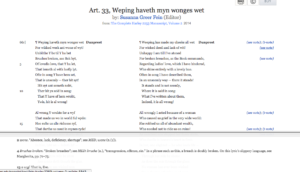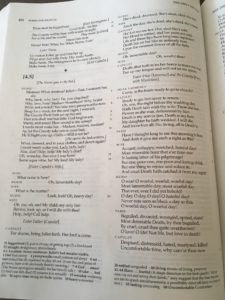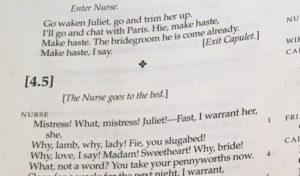The articles we read for today’s class compare Play the Knave to karaoke. The analogy suits the design of the game–the text of a Shakespearean play flits across the screen line-by-line, karaoke-style, and players perform the text as they read it. Since our past class discussions have centered on what constitutes an edition, what counts as a performance, and how products can be designed to suit the needs of the user, I’d like to explore how the karaoke-style gameplay of Play the Knave not only blurs the line between game and pedagogical tool, as suggested in one of Bloom’s articles, but also creates a new style of edition of Shakespeare. Moreover, I think that reading the Sutil article against the two Bloom pieces suggests that the game is structured to encourage two simultaneous performances of the text during gameplay–the live performance of the people reading out the lines, and the digital one where the avatars move. But how does this idiosyncratic textual environment change the user’s experience of the text?
Since the game presents the text of entire scenes, or even plays, we can think about it as a new type of edition of the text. In our class thus far, we’ve spent a considerable amount of discussion on what constitutes an edition of a text, and what constitutes a performance of the text. Play the Knave seems to occupy both spaces at once. As Bloom emphasizes in her articles and website, the game presents the plays’ text to its users karaoke-style, meaning that the text appears on the screen one line at a time, through the entirety of the scene being performed (“Theatre Full of Others” 1). Bloom also mentions, however, that her program allows for the sequential performance of an entire play, the clips of which can them be stitched into a continuous film of a play (“Videogame Shakespeare” 121). If the entirety of the play’s text can show up on the screen during gameplay, the game itself can act as an edition of the text.
The karaoke-style gameplay of Play the Knave crafts a different experience of Shakespeare than do other editions of the text because it forces the user to encounter the text in a hypersegmented, sequential way–the user gets the text one line at a time, can’t access past lines without replaying the scene, and can only enter the text at the beginnings of the scenes that the game makes available for play–depending on the game’s structure, it might not be possible to skip straight to the “to be or not to be” passage in Hamlet in the same way you can flip to it in a codex. Traditional print editions of Shakespeare offer the users multiple routes into the text–on a first encounter with the text, a reader could read it silently the entire way through, read parts aloud, act it out, or skip to any part the reader wants. The codex offers this kind of flexibility simply because its physical structure lets you flip to any part of the book, and doesn’t limit your time on any page of the text. The whole text is available at once. The karaoke-style game structure of Play the Knave, however, displays the text one line at a time, forcing the actor to experience the play line-by-line.
I think it’s important to a discussion of the reading experience Play the Knave presents to talk about how the game segments the plays into playable scenes. It’s difficult to tell from the website and articles, and so this piece of the conversation is one I’d like to encourage us to have in class. Is it segmented into traditional acts and scenes? French scenes? What are the scenes called on the menu? Can you skip to any scene you want, or does the game force you to experience them in order? This matters to the experience of the play since once a scene is selected, it plays through to the end of the scene. The ability to choose scenes is thus the only way to shuffle through the play for a particular moment in the text. If the game sticks to traditional scene divisions, it enforces the editorially entrenched divisions. If it goes by French scenes, I’m curious to know what the scenes have been called on the menu of the game–do they have numbers? Descriptive names? If so, how do the names influence the perception of the scene?
The game’s structure especially rewards physical acting above voice acting, pushing its viewers towards a performance style and experience of the text that either leans towards declamatory acting or outright clowning. I’m not saying this as a criticism of the game design–I think it’s neat–but I think it’s important to think about the implications of how the game structure asks the players to think about Shakespeare’s texts. As Bloom argues in both articles, the kinect-based motion capture technology encourages users to move as they read the lines (“Theatre Full of Others” 2). Moreover, the limitations of the kinect system mean that it has difficulty representing very small movements or very sudden ones, pushing the players towards a declamatory acting style since large gestures and deliberate movements show up well onscreen (“Theatre Full of Others” 8). The game’s structure thus rewards the sort of movements characteristic of declamatory acting with interesting movement from the avatars. However, it doesn’t reward voice acting in the same way–there’s not a points system that rewards you for stressing certain words, or reading the text fluently, or with passion, and I’m not sure how this sort of a system would even work. If the game’s structure makes motion matter much more than the text, it makes sense that declamatory acting could easily fade into clowning of the sort we see on one of Bloom’s demonstration videos on her website:
The users here move incongruously with the text on the screen–making their characters do push-ups and lean backwards. The game essentially rewards this acting style–the avatar also does the push-ups. It’s an interesting visual moment, if disconnected from the script. All the same, it shows that the game has the potential to encourage not only scene appropriate physical acting, but a clowning style that essentially ignores the words onscreen. The game prioritizes physical acting above an experience of the text, which, again, isn’t necessarily a bad thing, but is important to think about when discussing the impression it might give someone encountering Shakespeare or that play for the first time.
Essentially, the game encourages an experience of the text that is continuously grounded in embodied motion. It encourages a gestural Shakespeare, but the fact that players can’t backtrack to previous lines or watch the entire play scroll by before performing it means that their acting is contextualized by only whatever they’ve previously read of Shakespeare–whether that’s intensive study of the Shakespearean corpus, a couple plays in high school, or just the five lines of text that scrolled across the screen before their current line. I think this also encourages an understanding of the text and an acting style that responds mostly to the words currently on the screen, but that might not take into context the rest of the character’s development or the arc of the plot.
Moreover, Play the Knave isn’t just a text grounded in embodied motion, it’s also a text that gives players constant feedback on their motion, both from the audience around them and from the avatars onscreen. Even this choice changes some of the physicality of the players’ performances–the videos on Bloom’s website show that the players and audiences alike have a tendency to watch the avatars’ performances more than the live one. Accordingly, a couple of clips had actors face each other during conversation scenes, but with both of their faces turned towards the screen rather than to each other. While this also makes sense since the screen acts as a prompter, the constant feedback clearly also influences how players choose to move.
The other question I’d like to pose to the group this week is whether the game encourages the players to produce one performance of the text, or two of them at once. Both Bloom and Sutil’s language suggest that the digital environment mocap creates differs from its real world counterpart. Bloom defines the digital in her paper by quoting Matthew G. Kirschenbaum’s argument that a digital environment provides an illusion of perfect transmission and reproducibility (“Theatre Full of Others” 5). I’d love to invite Dr. Bloom to correct my understanding of the definition (it was a little difficult to follow as a non-specialist), but I understood it to mean that the digital gives off an illusion of a perfectly reproducible thing. Within the game, the appearance of perfect reproducibility occurs with movement: the motion onscreen seems like a reproduction of the human motion in front of the camera and its depth sensors. Yet, Bloom herself admits that part of the reason why the game encourages declamatory acting is because of the flaws in the game’s ability to reproduce motion accurately–it can’t capture subtle movements or sharp, sudden ones well, causing the avatar to move erratically or unnaturally when the mocap program can’t process the human movement quickly or accurately enough (“Theatre Full of Others” 8). In short, flaws in the technology mean that the motion onscreen will always be somehow qualitatively different from the ones in front of it–whether that’s in level of detail the lens captures or in a misanalysis of where the person is. This seems to agree with Sutil’s argument that mocap doesn’t translate motion onto the screen, but maps it onto the digital, creating a different thing (Sutil 206). I’d like to raise a question for the class to consider in response to these flaws in transposing the motion to the digital environment: are the onscreen performances the avatars give the same performance as the one their human counterparts put on? Or are they two distinct entities?
Moreover, the avatars provide continuous feedback on the players’ performances, which becomes especially interesting when we consider whether the avatar’s performances are another facet of the players’ performance or count as a separate performance of the text–if it’s the same one, players see their own performance in what seems to be real time; if it’s not, they see a mapping of their performance onto a second, digital performance. Regardless, the effect is similar–they are at once performers and spectators during the same reading of the text.
Play the Knave fills an interesting gap in Shakespeare products and in educational technology by offering a way to gamify Shakespeare’s text. The software arguably acts as an edition of the text even as it acts as a prompt towards performance–it presents the text line-by-line while an onscreen avatar mimics the motion of the players, encouraging players to act out the lines as they read. Yet, the mere fact that the game’s structure encourages performance at the same time as one encounters the text can’t help but influence readings of it, tying the text to declamatory gestures, and in some cases, reducing the player’s focus on the words themselves and encouraging clowning. The limitations of the kinect’s mocap technology also have interesting implications for how we think of the performance Play the Knave prompts–the flaws in reproducibility suggest that the digital performance might be well-classified as a separate performance of the text than the live performance from which it derives its motion.
Bibliography
Bloom, Gina. “Videogame Shakespeare: Enskilling Audiences through Theater-Making Games.” Shakespeare Studies, vol. 43, 2015, pp. 114–9.
Bloom, Gina, Sawyer Kemp, Nicholas Toothman, and Evan Buswell. “’A whole theater of others’: Amateur Acting and Immersive Spectatorship in the Digital Shakespeare Game Play the Knave.” Shakespeare Quarterly, (forthcoming).
Playing the Knave. Utah Installation 1. YouTube, https://www.youtube.com/watch?v=cV9cZlOnrkc. Accessed 20 Mar. 2017.
Sutil, Nicolás Salazar. “The Language of Motion Capture.” Motion and Representation: The Language of Human Movement, MIT Press, 2015, pp. 197–209. Google Scholar, https://books.google.com/books?hl=en&lr=&id=fD87CQAAQBAJ&oi=fnd&pg=PT7&dq=motion+and+representation+sutil&ots=oW-NMiwPy0&sig=5H2jH0Ccqn3PVoajn_gq_kBMNu4.
Videos – Play the Knave. http://playtheknave.org/videos/. Accessed 20 Mar. 2017.



 scene beginnings is interesting in conjunction with the way Bevington formats scene beginnings in the main body of the text. Although Bevington’s edition has text in each of the three lines of print dividing scene four from scene 5, the scene number is in a large font, making these three lines take up space equivalent to sic regular lines of the play. Accordingly, these three lines of print leave substantial negative space between scenes, accentuating the division between them. The small clover-shaped flourish at the end of scene four and the bold typeface for the scene number heighten this division. However, both the scene numbers and stage directions are offset with square brackets, which at once make it explicit that these additions are editorial interventions and perhaps also add a visual sense of uncertainty–although these are the traditional scene divisions, they’re tentatively put forward as the result of editorial tradition rather than words from Shakespeare’s pen. Like the location notes, the formatting of the scene change is at once designed to provide a clear division between the scenes, and to show that these subdivisions of the text and editorial interventions may not have been available to a contemporary reader of the play.
scene beginnings is interesting in conjunction with the way Bevington formats scene beginnings in the main body of the text. Although Bevington’s edition has text in each of the three lines of print dividing scene four from scene 5, the scene number is in a large font, making these three lines take up space equivalent to sic regular lines of the play. Accordingly, these three lines of print leave substantial negative space between scenes, accentuating the division between them. The small clover-shaped flourish at the end of scene four and the bold typeface for the scene number heighten this division. However, both the scene numbers and stage directions are offset with square brackets, which at once make it explicit that these additions are editorial interventions and perhaps also add a visual sense of uncertainty–although these are the traditional scene divisions, they’re tentatively put forward as the result of editorial tradition rather than words from Shakespeare’s pen. Like the location notes, the formatting of the scene change is at once designed to provide a clear division between the scenes, and to show that these subdivisions of the text and editorial interventions may not have been available to a contemporary reader of the play.
Mark Rose–“Pope vs Curll”
Rose’s first article summarizes the case that first established that authors have intellectual property rights over their works, and discusses both the effects of the court decision and how the case is situated within contemporary notions of the role of the author and of how the book trade works. Alexander Pope sued the bookseller Edmund Curll in June 1741 for publishing a series of letters exchanged between Pope and Dean Swift without Pope’s permission. Rose situates the case historically: the eighteenth century marks a period of transition from the patronage system to one more like our current system of literary production, and so he both emphasizes the legal precedent for the Pope suit and the way in which its ideological focus differs from current conceptions of copyright.
The legal precedent for Pope V. Curll is the 1710 Statute of Anne, which established that authors were the original owners of the rights to their works. It was based upon current patent law, and hence allowed authors and booksellers the right to their works for fourteen years, and twenty-one years for works that predated the statute. However, despite legal grounds for authorial copyright, Rose suggests that the participants in the case wouldn’t have viewed the case as a violation of property rights so much as a violation of propriety–it’s a publication of personal correspondence, which Pope argued was ungentlemanly to do without permission of both the authors and recipients of the letters. Pope claimed copyright over both the letters he wrote and the letters he received, however the case decided that he only had copyright over the letters he personally composed, not those written to him. This distinction is actually essential to our current notion of copyright because the case forced the judge to distinguish between the material property of the received letter, which belongs to the recipient, and the immaterial property of the text of the letter, which belongs to the author.
Rose, however, suggests that Pope’s motivations were somewhat mercenary for the time–he suggests that Pope tricked Curll into publishing his letters without authorization so that Pope could then publish an authorized version of his letters without seeming indecorous for doing so.
“The Author as Proprietor: Donaldson v. Becket and the Genealogy of Modern Authorship”
Rose’s second article details the circumstances behind the one of the next instrumental cases in the history of copyright law, Donaldson v. Becket, which centred around the question of whether or not authors owned intellectual rights to their books in perpetuity, and subsequently, whether the booksellers they transferred these rights to could keep them in perpetuity the same way they could keep an inherited property.
Rose argues that three cultural forces propel the development of copyright–mass-market publication, the valorization of original genius, and Locke’s idea that a person’s work is by right theirs. He argues that these concepts merge into the notion of the author as proprietor in the eighteenth century
Rose also argues that the emerging concept of copyright forced people to renegotiate the concepts of author and text. The proponents of perpetual copyright had to argue that the text itself of the author is akin to property in the author’s possession, which again differentiated between the physical manuscript the author owned and the intellectual property of the text itself. Conversely, those in favour of limited copyright argued that the ideas in a book were akin to those in patents, and should be legislated as such, while the proponents of eternal copyright argued that the essence of a literary work was inherent in the style and composition rather than simply mere ideas. The net result of the debate was that aspects of each group’s position became entrenched in the conception of what authorship and literature are–literary works were seen as property, and as intangible objects that included the sentiment and style of the author’s prose, yet the court’s ruling in favour of limited copyright also conceived of literary works, in a broad sense, as a sort of idea or social good that should be made available to the public after a span of time. In short, the debate forced a renegotiation of the idea of what literature and composition entail even as the case proceeded.
I thought Rose’s articles were lucid examinations of the relationship between copyright legislation and the popular conception of authorship and literary texts. Rose was at times repetitive, however, on the whole, I felt that the articles contextualized copyright legislation within the cultural moment of 18th century England well, and that they traced the development of the notion of the author as it was reflected on copyright rulings.